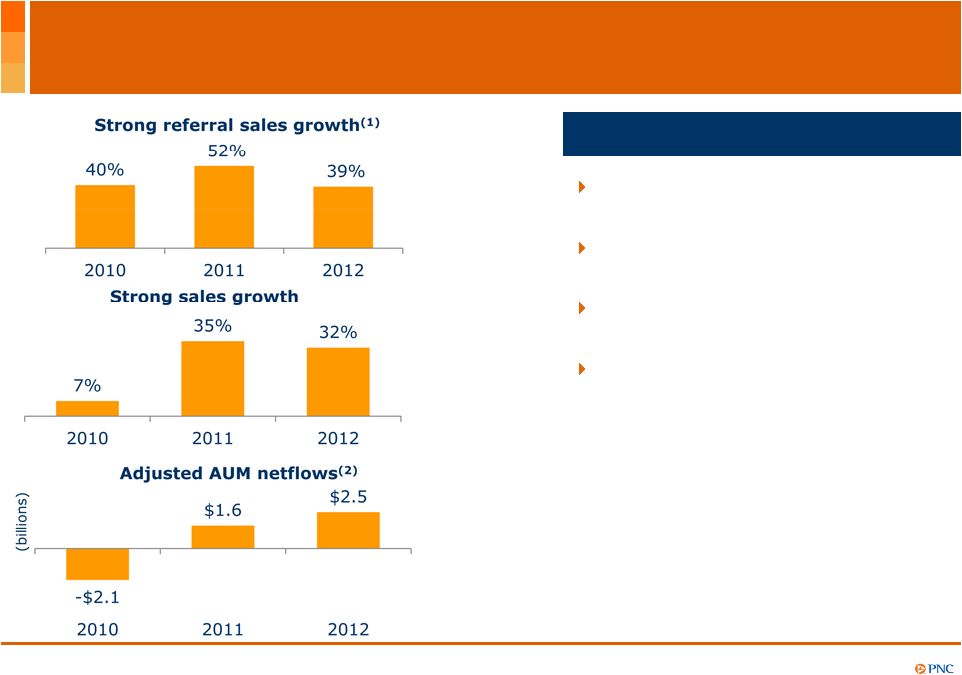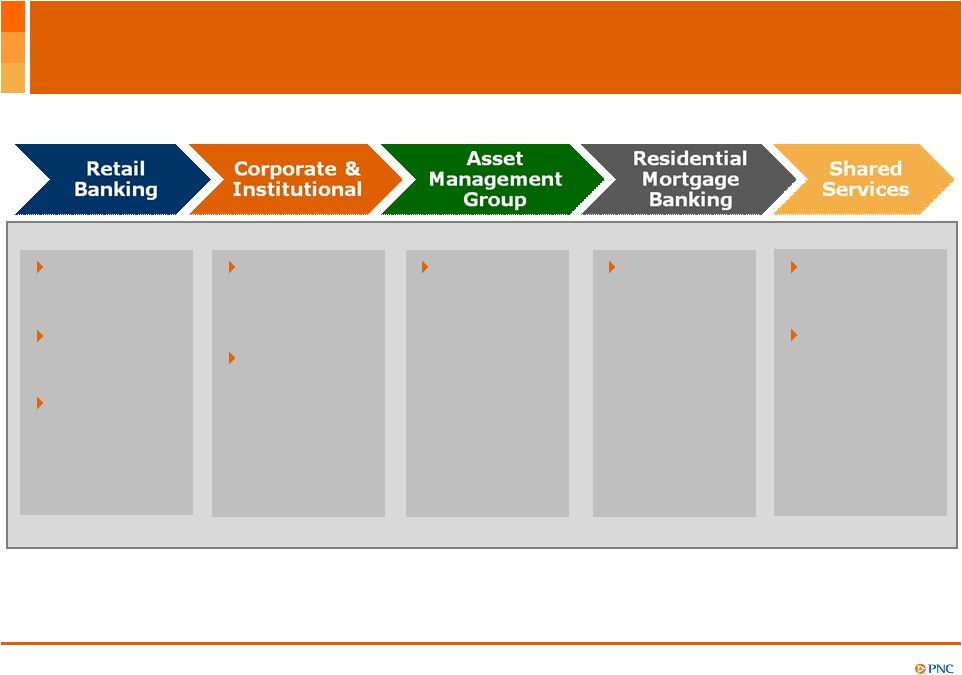Attached files
| file | filename |
|---|---|
| 8-K - FORM 8-K - PNC FINANCIAL SERVICES GROUP, INC. | d498187d8k.htm |
 The PNC
Financial Services Group, Inc. Citigroup 2013 Financial Services Conference
March 5, 2013
Exhibit 99.1 |
 2
Cautionary Statement Regarding Forward-Looking
Information and Adjusted Information
This
presentation
includes
“snapshot”
information
about
PNC
used
by
way
of
illustration.
It
is
not
intended
as
a
full
business
or
financial
review
and
should
be
viewed
in
the
context
of
all
of
the
information
made
available
by
PNC
in
its
SEC
filings.
The
presentation
also
contains
forward-looking
statements
regarding
our
outlook
for
earnings,
revenues,
expenses,
capital
levels
and
ratios,
liquidity
levels,
asset
levels,
asset
quality,
financial
position,
and
other
matters
regarding
or
affecting
PNC
and
its
future
business
and
operations.
Forward-looking
statements
are
necessarily
subject
to
numerous
assumptions,
risks
and
uncertainties,
which
change
over
time.
The
forward-looking
statements
in
this
presentation
are
qualified
by
the
factors
affecting
forward-looking
statements
identified
in
the
more
detailed
Cautionary
Statement
included
in
the
Appendix,
which
is
included
in
the
version
of
the
presentation
materials
posted
on
our
corporate
website
at
www.pnc.com/investorevents
and
in
our
SEC
filings.
We
provide
greater
detail
regarding
these
as
well
as
other
factors
in
our
2012
Form
10-K,
including
in
the
Risk
Factors
and
Risk
Management
sections
and
in
the
Legal
Proceedings
and
Commitments
and
Guarantees
Notes
of
the
Notes
to
Consolidated
Financial
Statements
in
that
report,
and
in
our
subsequent
SEC
filings.
Our
forward-looking
statements
may
also
be
subject
to
other
risks
and
uncertainties,
including
those
we
may
discuss
in
this
presentation
or
in
SEC
filings,
accessible
on
the
SEC’s
website
at
www.sec.gov
and
on
PNC’s
corporate
website
at
www.pnc.com/secfilings.
We
have
included
web
addresses
in
this
presentation
as
inactive
textual
references
only.
Information
on
these
websites
is
not
part
of
this
presentation.
Future
events
or
circumstances
may
change
our
outlook
and
may
also
affect
the
nature
of
the
assumptions,
risks
and
uncertainties
to
which
our
forward-looking
statements
are
subject.
Forward-looking
statements
in
this
presentation
speak
only
as
of
the
date
of
this
presentation.
We
do
not
assume
any
duty
and
do
not
undertake
to
update
those
statements.
Actual
results
or
future
events
could
differ,
possibly
materially,
from
those
anticipated
in
forward-
looking
statements,
as
well
as
from
historical
performance.
In
this
presentation,
we
may
sometimes
refer
to
adjusted
results
to
help
illustrate
the
impact
of
certain
types
of
items,
such
as
provisions
for
residential
mortgage
repurchase
obligations,
gains
on
sales
of
a
portion
of
our
VISA
shares,
non-cash
charges
related
to
redemptions
of
trust
preferred
securities,
expenses
for
residential
mortgage
foreclosure-related
matters,
goodwill
impairment
charge
and
integration
costs.
This
information
supplements
our
results
as
reported
in
accordance
with
GAAP
and
should
not
be
viewed
in
isolation
from,
or
as
a
substitute
for,
our
GAAP
results.
We
believe
that
this
additional
information
and
the
reconciliations
we
provide
may
be
useful
to
investors,
analysts,
regulators
and
others
to
help
evaluate
the
impact
of
these
respective
items
on
our
operations.
Where
applicable,
we
provide
GAAP
reconciliations
for
such
additional
information,
including
in
the
slides,
the
Appendix
and/or
other
slides
and
materials
on
our
corporate
website
at
www.pnc.com/investorevents
and
in
our
SEC
filings
We
may
also
use
annualized,
proforma,
estimated
or
third
party
numbers
for
illustrative
or
comparative
purposes
only.
These
may
not
reflect
actual
results.
This
presentation
may
also
include
discussion
of
other
non-GAAP
financial
measures,
which,
to
the
extent
not
so
qualified
therein
or
in
the
Appendix,
is
qualified
by
GAAP
reconciliation
information
available
on
our
corporate
website
at
www.pnc.com
under
“About
PNC–Investor
Relations.” |
 3
2013 Key Priorities
(1)
Grow customers and improve profitability
Continue to grow deposits, loans and revenues
Deliver positive operating leverage
–
Increase
ratio
of
fee
income
to
total
revenue
–
Decrease
expenses
by
mid-single
digits,
core
expenses
(2)
flat
Maintain strong risk discipline
Well-positioned
to
achieve
Basel
III
goal
(3)
(1)
Refer
to
Cautionary
Statement
in
the
Appendix,
including
economic
and
other
assumptions.
Does
not
take
into
account
the
impact
of
potential
legal
and
regulatory
contingencies.
(2)
Core
expenses
do
not
include
any
integration
costs
or
noncash
charges
for
unamortized
discounts
related
to
redemption
of
hybrid
capital
securities.
(3)
Basel
III
Tier
1
common
capital
ratio
goal
is
to
be
within
the
range
of
8.0-8.5%
by
year-end
2013without
the
benefit
of
phase-ins,
based
on
our
current
understanding
of
Basel
III
NPRs
and
estimates
of
Basel
II
(with
proposed
modifications)
risk-weighted
assets.
Includes
application
of
Basel
II.5.
Subject
to
further
regulatory
clarity
and
development,
validation
and
regulatory
approval
of
Basel
models. |
 4
Improve Profitability of Growing Customer Base
(1)
Net
new
organic
checking
relationship
growth
refers
to
new
consumer
and
small
business
accounts
exclusive
of
accounts
acquired
through
acquisition.
(2)
A
Corporate
Banking
primary
client
is
defined
as
a
corporate
banking
relationship
with
annual
revenue
generation
of
$50,000
or
more
or,
within
corporate
banking,
a
commercial
banking
client
relationship
with
annual
revenue
generation
of
$10,000
or
more.
(3)
An
Asset
Management
Group
primary
client
is
defined
as
a
client
relationship
with
annual
revenue
generation
of
$10,000
or
more.
(4)
A
mortgage
with
a
borrower
as
part
of
a
residential
real
estate
purchase
transaction.
Asset Management Group
Residential Mortgage
Retail Banking
Corporate Banking |
 5
2011-2012 revenue growth
2011-2012 net loan growth
2011-2012 deposit growth
Peer
Source:
SNL
Database.
Deposit
and
net
loan
growth
based
on
balances
at
December
31 ,
2011
and
2012,
respectively.
Revenue
growth
based
on
change
for
2012
vs.
2011.
Data
reflects
acquisitions.
Continue to Grow Deposits, Loans and Revenues
st |
 6
(1) Noninterest income and total revenue each adjusted for impact of residential mortgage
repurchase provision and gain on sale of VISA shares, as applicable. Further
information provided in the Appendix. Retail Banking
Deepen cross-sell and share of wallet
Broaden sources of revenue –
Investment and
Retirement opportunity (Consumer Services)
Corporate & Institutional Banking
Pursue cross-sell opportunities with clients
added in last three years
Leverage new and underpenetrated markets
as well as targeted verticals
Asset Management Group
Distribution build out in newly acquired
markets
Capture more investable assets in
underpenetrated client segments
Residential Mortgage Banking
Drive higher purchase origination volume
Deeper market penetration and cross-sell
Strategies to Grow Fee Income |
 7
Strategic Growth Priorities
Drive growth in newly acquired and underpenetrated
markets
Capture more investable assets
Build a stronger Residential Mortgage Banking
business
Redefine the Retail Banking business |
 8
Total Corporate Banking and AMG sales
Total Corporate Banking and AMG cross-sales
Corporate Banking is a business within Corporate & Institutional. AMG refers to Asset
Management Group. Highlights
Building momentum in Midwest
markets
Regional President model key to
success in newly acquired markets
Southeast revenue opportunities
–
Fully
staffed
–
Sales
teams
now
in
place
–
Winning
new
clients
Significant cross-sell opportunities
–
Treasury
Management
–
Capital
Markets
–
Innovative
Retail
products
Deeper Penetration and Cross-sell in Newly Acquired
Markets |
 9
Asset Management Group –
Build on Strong Business
Model
A top 10 U.S. bank held wealth
manager
Approaching $1 billion in annual
revenues
Referral sales contributed 36% of
total sales in 2012
Investment and Retirement growth
opportunity
–
Capturing
more
investable
assets
in
underpenetrated
client
segments
–
Southeast
market
represents
$800B
(3)
potential
high
net
worth
investable
assets
(1)
Referral
sales
are
new
sales
from
clients
referred
to
AMG
by
Retail
Banking
or
Corporate
and
Institutional
Banking.
(2)
Adjusted
AUM
netflows
defined
as
total
netflows
after
adjustment
for
cyclical
client
activities.
(3)
Represents
the
value
of
investments
by
individuals
in
the
states
represented
by
the
RBC
Bank
(USA)
acquisition
even
where
it
overlaps
with
prior
PNC
states
such
as
Florida.
Source:
Data
Analytics
Research
using
IXI
household
data.
(1)
Highlights |
 10
Building a Stronger Residential Mortgage Banking
Business
PNC’s advantages in Residential
Mortgage Banking
–
Leverage
balance
sheet
strength
–
Retail
channels
only
–
National
distribution
–
High
customer
satisfaction
–
Integrated
with
PNC
Bank
Origination priorities
–
Purchase
(1)
business
growth
–
Strong
credit
quality
Servicing priorities
–
Full
compliance
and
moderate
risk
philosophy
–
Optimize
servicing
portfolio
size
Growing the right way
Highlights
Residential Mortgage Banking Originations
(1)
Purchase
is
defined
as
a
mortgage
with
a
borrower
as
part
of
a
residential
real
estate
purchase
transaction. |
 11
Migrate from dense branch to technology-
centric branch network presence to drive
efficient growth
Technology enabled convenience and
experience
Customer data insight
Drive more efficient growth and share of
profitable customer relationships
Smaller segment
“stores”
& kiosks
in branches
Mobile stores,
street teams and
educational
events
Remote sales
force specialists
Extensive full
function ATM network
Digital Call Center
-
Chat
-
Social Media
Digital Marketing
Mobile Deposit
Deposit Scanner
Serving Customers Tomorrow -
Redefining the Retail
Branch Network |
 12
Managing Expenses -
2013 Expense Opportunities
(1)
Lower service
delivery costs
Branch
consolidation
Staffing and
back office
efficiencies
Enhance
staffing
model
Review loan
origination
process
Online
investment
platform
and
centralized
services
Lower
mortgage
foreclosure
compliance
costs
Staffing
efficiencies
Continued
focus on
consulting
expense
reductions
(1)
Refer
to
Cautionary
Statement
in
the
Appendix,
including
economic
and
other
assumptions.
Does
not
take
into
account
the
impact
of
potential
legal
and
regulatory
contingencies. |
 13
Key Takeaways
(1)
Strategic growth priorities to create long-term value
Managing expenses –
Continuous Improvement
savings to fund future investment capacity
Positioned in 2013 to deliver improved earnings
quality and positive operating leverage
Strong capital position to provide greater flexibility
in 2014
PNC Continues to Build a Great Company.
PNC Continues to Build a Great Company.
(1) Refer to Cautionary Statement in the Appendix, including economic and other assumptions.
Does not take into account the impact of potential legal and regulatory contingencies.
|
 14
Cautionary Statement Regarding Forward-Looking
Information
This
presentation
includes
“snapshot”
information
about
PNC
used
by
way
of
illustration
and
is
not
intended
as
a
full
business
or
financial
review.
It
should
not
be
viewed
in
isolation
but
rather
in
the
context
of
all
of
the
information
made
available
by
PNC
in
its
SEC
filings.
We
also
make
statements
in
this
presentation,
and
we
may
from
time
to
time
make
other
statements,
regarding
our
outlook
for
earnings,
revenues,
expenses,
capital
levels
and
ratios,
liquidity
levels,
asset
levels,
asset
quality,
financial
position,
and
other
matters
regarding
or
affecting
PNC
and
its
future
business
and
operations
that
are
forward-looking
statements
within
the
meaning
of
the
Private
Securities
Litigation
Reform
Act.
Forward-
looking
statements
are
typically
identified
by
words
such
as
“believe,”
“plan,”
“expect,”
“anticipate,”
“see,”
“look,”
“intend,”
“outlook,”
“project,”
“forecast,”
“estimate,”
“goal,”
“will,”
“should”
and
other
similar
words
and
expressions.
Forward-looking
statements
are
subject
to
numerous
assumptions,
risks
and
uncertainties,
which
change
over
time.
Forward-looking
statements
speak
only
as
of
the
date
made.
We
do
not
assume
any
duty
and
do
not
undertake
to
update
forward-looking
statements.
Actual
results
or
future
events
could
differ,
possibly
materially,
from
those
anticipated
in
forward-looking
statements,
as
well
as
from
historical
performance.
Our forward-looking statements are subject to the following principal risks and
uncertainties. •Our businesses, financial results and balance sheet values are
affected by business and economic conditions, including the following: o
Changes in interest rates and valuations in debt, equity and other financial markets.
o
Disruptions in the liquidity and other functioning of U.S. and global financial markets.
o
The
impact
on
financial
markets
and
the
economy
of
any
changes
in
the
credit
ratings
of
U.S.
Treasury
obligations
and
other
U.S.
government-
backed
debt,
as
well
as
issues
surrounding
the
level
of
U.S.
and
European
government
debt
and
concerns
regarding
the
creditworthiness
of
certain
sovereign
governments,
supranationals
and
financial
institutions
in
Europe.
o
Actions by Federal Reserve, U.S. Treasury and other government agencies, including those that
impact money supply and market interest rates. o
Changes in customers’, suppliers’
and other counterparties’
performance and creditworthiness.
o
Slowing or failure of the current moderate economic expansion.
o
Continued
effects
of
aftermath
of
recessionary
conditions
and
uneven
spread
of
positive
impacts
of
recovery
on
the
economy
and
our
counterparties,
including
adverse
impacts
on
levels
of
unemployment,
loan
utilization
rates,
delinquencies,
defaults
and
counterparty
ability
to
meet
credit
and
other
obligations.
o
Changes
in
customer
preferences
and
behavior,
whether
due
to
changing
business
and
economic
conditions,
legislative
and
regulatory
initiatives,
or
other
factors.
•Our
forward-looking
financial
statements
are
subject
to
the
risk
that
economic
and
financial
market
conditions
will
be
substantially
different
than
we
are
currently
expecting.
These
statements
are
based
on
our
current
view
that
the
moderate
economic
expansion
will
persist
and
interest
rates
will
remain
very
low
in
2013,
despite
drags
from
Federal
fiscal
restraint
and
a
European
recession.
These
forward-looking
statements
also
do
not,
unless
otherwise
indicated,
take
into
account
the
impact
of
potential
legal
and
regulatory
contingencies.
•PNC’s
regulatory
capital
ratios
in
the
future
will
depend
on,
among
other
things,
the
company’s
financial
performance,
the
scope
and
terms
of
final
capital
regulations
then
in
effect
(particularly
those
implementing
the
Basel
Capital
Accords),
and
management
actions
affecting
the
composition
of
PNC’s
balance
sheet.
In
addition,
PNC’s
ability
to
determine,
evaluate
and
forecast
regulatory
capital
ratios,
and
to
take
actions
(such
as
capital
distributions)
based
on
actual
or
forecasted
capital
ratios,
will
be
dependent
on
the
ongoing
development,
validation
and
regulatory
approval
of
related
models.
Appendix |
 15
Cautionary Statement Regarding Forward-Looking
Information (continued)
•Legal
and
regulatory
developments
could
have
an
impact
on
our
ability
to
operate
our
businesses,
financial
condition,
results
of
operations,
competitive
position,
reputation,
or
pursuit
of
attractive
acquisition
opportunities.
Reputational
impacts
could
affect
matters
such
as
business
generation
and
retention,
liquidity,
funding,
and
ability
to
attract
and
retain
management.
These
developments
could
include:
o
Changes
resulting
from
legislative
and
regulatory
reforms,
including
major
reform
of
the
regulatory
oversight
structure
of
the
financial
services
industry
and
changes
to
laws
and
regulations
involving
tax,
pension,
bankruptcy,
consumer
protection,
and
other
industry
aspects,
and
changes
in
accounting
policies
and
principles.
We
will
be
impacted
by
extensive
reforms
provided
for
in
the
Dodd-Frank
Wall
Street
Reform
and
Consumer
Protection
Act
(the
“Dodd-Frank
Act”)
and
otherwise
growing
out
of
the
recent
financial
crisis,
the
precise
nature,
extent
and
timing
of
which,
and
their
impact
on
us,
remains
uncertain.
o
Changes to regulations governing bank capital and liquidity standards, including due to the
Dodd-Frank Act and to Basel-related initiatives. o
Unfavorable
resolution
of
legal
proceedings
or
other
claims
and
regulatory
and
other
governmental
investigations
or
other
inquiries.
In
addition
to
matters
relating
to
PNC’s
business
and
activities,
such
matters
may
include
proceedings,
claims,
investigations,
or
inquiries
relating
to
pre-
acquisition
business
and
activities
of
acquired
companies,
such
as
National
City.
These
matters
may
result
in
monetary
judgments
or
settlements
or
other
remedies,
including
fines,
penalties,
restitution
or
alterations
in
our
business
practices,
and
in
additional
expenses
and
collateral
costs,
and
may
cause
reputational
harm
to
PNC.
o
Results
of
the
regulatory
examination
and
supervision
process,
including
our
failure
to
satisfy
requirements
of
agreements
with
governmental
agencies.
o
Impact
on
business
and
operating
results
of
any
costs
associated
with
obtaining
rights
in
intellectual
property
claimed
by
others
and
of
adequacy
of
our
intellectual
property
protection
in
general.
•Business
and
operating
results
are
affected
by
our
ability
to
identify
and
effectively
manage
risks
inherent
in
our
businesses,
including,
where
appropriate,
through
effective
use
of
third-party
insurance,
derivatives,
and
capital
management
techniques,
and
to
meet
evolving
regulatory
capital
standards.
In
particular,
our
results
currently
depend
on
our
ability
to
manage
elevated
levels
of
impaired
assets.
•Business
and
operating
results
also
include
impacts
relating
to
our
equity
interest
in
BlackRock,
Inc.
and
rely
to
a
significant
extent
on
information
provided
to
us
by
BlackRock.
Risks
and
uncertainties
that
could
affect
BlackRock
are
discussed
in
more
detail
by
BlackRock
in
its
SEC
filings.
•Our
2012
acquisition
of
RBC
Bank
(USA)
presents
us
with
risks
and
uncertainties
related
to
the
integration
of
the
acquired
businesses
into
PNC,
including:
o
Anticipated
benefits
of
the
transaction,
including
cost
savings
and
strategic
gains,
may
be
significantly
harder
or
take
longer
to
achieve
than
expected
or
may
not
be
achieved
in
their
entirety
as
a
result
of
unexpected
factors
or
events.
o
Our
ability
to
achieve
anticipated
results
from
this
transaction
is
dependent
also
on
the
extent
of
credit
losses
in
the
acquired
loan
portfolios
and
the
extent
of
deposit
attrition,
in
part
related
to
the
state
of
economic
and
financial
markets.
Also,
litigation
and
regulatory
and
other
governmental
investigations
that
may
be
filed
or
commenced
relating
to
the
pre-acquisition
business
and
activities
of
RBC
Bank
(USA)
could
impact
the
timing
or
realization
of
anticipated
benefits
to
PNC.
o
Integration
of
RBC
Bank
(USA)’s
business
and
operations
into
PNC
may
take
longer
than
anticipated
or
be
substantially
more
costly
than
anticipated
or
have
unanticipated
adverse
results
relating
to
RBC
Bank
(USA)’s
or
PNC’s
existing
businesses.
PNC’s
ability
to
integrate
RBC
Bank
(USA)
successfully
may
be
adversely
affected
by
the
fact
that
this
transaction
results
in
PNC
entering
several
geographic
markets
where
PNC
did
not
previously
have
any
meaningful
retail
presence.
Appendix |
 16
Cautionary Statement Regarding Forward-Looking
Information (continued)
•In
addition
to
the
RBC
Bank
(USA)
transaction,
we
grow
our
business
in
part
by
acquiring
from
time
to
time
other
financial
services
companies,
financial
services
assets
and
related
deposits
and
other
liabilities.
These
other
acquisitions
often
present
risks
and
uncertainties
analogous
to
those
presented
by
the
RBC
Bank
(USA)
transaction.
Acquisition
risks
include
those
presented
by
the
nature
of
the
business
acquired
as
well
as
risks
and
uncertainties
related
to
the
acquisition
transactions
themselves,
regulatory
issues,
and
the
integration
of
the
acquired
businesses
into
PNC
after
closing.
•Competition
can
have
an
impact
on
customer
acquisition,
growth
and
retention
and
on
credit
spreads
and
product
pricing,
which
can
affect
market
share,
deposits
and
revenues.
Industry
restructuring
in
the
current
environment
could
also
impact
our
business
and
financial
performance
through
changes
in
counterparty
creditworthiness
and
performance
and
in
the
competitive
and
regulatory
landscape.
Our
ability
to
anticipate
and
respond
to
technological
changes
can
also
impact
our
ability
to
respond
to
customer
needs
and
meet
competitive
demands.
•Business
and
operating
results
can
also
be
affected
by
widespread
natural
and
other
disasters,
dislocations,
terrorist
activities
or
international
hostilities
through
impacts
on
the
economy
and
financial
markets
generally
or
on
us
or
our
counterparties
specifically.
We
provide
greater
detail
regarding
these
as
well
as
other
factors
in
our
2012
Form
10-K,
including
in
the
Risk
Factors
and
Risk
Management
sections
and
the
Legal
Proceedings
and
Commitments
and
Guarantees
Notes
of
the
Notes
to
Consolidated
Financial
Statements
in
that
report,
and
in
our
subsequent
SEC
filings.
Our
forward-looking
statements
may
also
be
subject
to
other
risks
and
uncertainties,
including
those
we
may
discuss
elsewhere
in
this
presentation
or
in
SEC
filings,
accessible
on
the
SEC’s
website
at
www.sec.gov
and
on
our
corporate
website
at
www.pnc.com/secfilings.
We
have
included
these
web
addresses
as
inactive
textual
references
only.
Information
on
these
websites
is
not
part
of
this
document.
Any
annualized,
proforma,
estimated,
third
party
or
consensus
numbers
in
this
presentation
are
used
for
illustrative
or
comparative
purposes
only
and
may
not
reflect
actual
results.
Any
consensus
earnings
estimates
are
calculated
based
on
the
earnings
projections
made
by
analysts
who
cover
that
company.
The
analysts’
opinions,
estimates
or
forecasts
(and
therefore
the
consensus
earnings
estimates)
are
theirs
alone,
are
not
those
of
PNC
or
its
management,
and
may
not
reflect
PNC’s
or
other
company’s
actual
or
anticipated
results.
Appendix |
 17
Non-GAAP to GAAP Reconcilement
For the three months ended
In millions
Jun. 30, 2012
Sep. 30, 2012
Dec. 31, 2012
Total noninterest income, as reported
$1,097
$1,689
$1,645
Total revenue, as reported
$3,623
$4,088
$4,069
Adjustments:
Provision for residential mortgage repurchase obligations
438
37
254
Gain on sale of Visa Class B common shares
-
(137)
(130)
Total noninterest income, as adjusted
$1,535
$1,589
$1,769
Total revenue, as adjusted
$4,061
$3,988
$4,193
Total noninterest income to total revenue, as reported
30%
41%
40%
Total noninterest income to total revenue, as adjusted
38%
40%
42%
PNC believes that information adjusted for the impact of certain items may be useful to help
evaluate the impact of those items on our operations.
Appendix |
 18
Peer Group of Banks
Appendix
The PNC Financial Services Group, Inc.
PNC
BB&T Corporation
BBT
Bank of America Corporation
BAC
Capital One Financial, Inc.
COF
Comerica Inc.
CMA
Fifth Third Bancorp
FITB
JPMorgan Chase
JPM
KeyCorp
KEY
M&T Bank
MTB
Regions Financial Corporation
RF
SunTrust Banks, Inc.
STI
U.S. Bancorp
USB
Wells Fargo & Co.
WFC |
